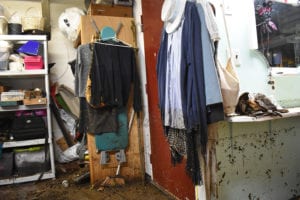Town of Brookhaven Supervisor Ed Romaine (R) has served in elected office for decades. In Part I of this two-part series, Romaine discusses the problem of coastal erosion, innovative ideas for recycling and why you won’t see his name on a sign at a town park.
What sparked your interest in environmental protection and which issues concern you the most?
Long ago, I made a choice between my eyes and my ears, and I chose my eyes. People can argue whatever they want, but I’ve seen what this Island was. I grew up on Long Island. I’ve watched it change and I know what it needs.
The things that concern me about this Island are the threat of climate change and rising sea levels, which is why we’ve bought hundreds of acres at Mastic Beach — to convert them back to wetlands, to act as a sponge.
The week before I was elected in 2012, Hurricane Sandy hit. I went down to Mastic Beach, which was part of my original district in the ’80s. I knew the mayor and I went down with Dan Panico [R-Manorville], who was the councilman, and we took a tour.
Neighborhood Road is the road that runs east and west through Mastic Beach. Everything south of Neighborhood Road was flooded. And the other thing I remember about that disaster was the smell. With all the trees and the downed wires sparking, it smelled of sewage because all their cesspools were inundated, and it smelled of oil because they all had above-ground tanks that spilled over.
It was so devastating when I went down there. Mastic Beach has recovered since, but I will never forget the disaster that hurricane caused and the flooding that it unleashed. Marshlands act as sponges that are capable of handling a flood like that. That is why I am deeply invested in trying to buy up as much of the marshland that was built upon years ago and get rid of some of the small homes there.
The other concern is the carbon footprint we leave. I’m a big supporter of renewable energy. When I was a [county] legislator for the 1st District, I bought more land and preserved more farmland than the other 17 districts combined.
The pattern of development has been so intense that we’ve screwed up this Island by sprawl. We should have thought more carefully about the pattern of development here and what we could do in terms of public transport, in terms of public services — and we didn’t.
What is your preferred approach to the issue of eroding bluffs, a growing problem along the North Shore?
Sometimes people live along those bluffs, so you want to see what type of engineering solutions there are to secure or stabilize bluffs. I know the Village of Port Jefferson is debating what to do about the Port Jefferson Country Club because their tennis courts are going to fall in [the Long Island Sound] and then right after that, probably the clubhouse.
My view would be the same as it would be for Mastic Beach — to retreat from the bluffs. But again, sometimes you can’t do that because people live atop them, so you have to look at engineering solutions that would help stabilize the bluffs. It’s Mother Nature at work. Can man-made solutions resolve it? Sure they can … temporarily. Clearly, what should have been done is something that would have prevented building near or on the bluffs.
Can you discuss the recycling initiative that your office has undertaken?
Back in 2017, China announced its [Operation] National Sword policy. It said, “Hey, we’re not buying any more recycled goods from the United States.” Well, that created all types of problems.
Unfortunately with recycling, a lot of what needs to be recycled rests with the State of New York, and they have not been innovative. The [Department of Environmental Conservation] has chosen to be a regulator and not an innovator. Let me give you an example: glass.
Glass is one of the largest contaminants in the recycling process. To recycle, what do you need? You need a marketplace. Recycling doesn’t work if you don’t have a marketplace to reuse the goods that you’re recycling, which is why recycling has collapsed in large parts of this country.
What we’re looking for from the State of New York is called a BUD — a beneficial-use determination. We believe glass should be an aggregate used in concrete. Concrete is the most carbon-intensive production of any substance that we know. And the way you can end that is by substituting glass in that process as an aggregate, and we’ve allocated for that.
What this requires is the state DEC to give us a beneficial-use determination. Now we’ve proved that because we’ve built these huge drainage rings for our recycling center and we got state permission to use glass as the aggregate in the concrete. They are not even looking at that.
At Stony Brook University, there’s a boathouse. It’s painted blue and was built in 1989. Do you know what it was built out of? Ash. The strength of that building is stronger today than the day it was built in 1989. Guess what we do with our ash? We put it in our landfill. Yet we don’t get a beneficial-use determination to use ash in concrete, in asphalt or in other products. This would create a market for glass and ash.
Also, I’m waiting on the state legislation. I have an ally in the state Legislature — an old friend of mine, someone I served with in the [county] Legislature in the ’80s, and we still work together to this day: [Assemblyman] Steve Englebright [D-Setauket]. I’m trying to say, “Steve, what are we doing here? There’s so much we can be doing.” We need a “Bigger, Better Bottle Bill.” We need to create markets for products because if we don’t, recycling will not work and will not be effective.
If you give enough time and you watch a leaky faucet, that water one drop at a time over a long period of time will make a difference. I always remind myself of the one drop of water. Because if you keep on hammering away at it, change will come. If only incrementally, it will come for the better, for things that should come, for things that are so common sense that even the opposition can’t argue against it. And usually, the opposition tends to be monied interests that have some kind of economic benefit to them, not to the society as a whole.
How did you end up in the supervisor’s office?
I started out as a teacher. I taught for 12 years, almost all of it at Hauppauge. I was very active in the teachers union there. I was the treasurer of the teachers union on their executive committee. In fact, one of my students was Jay Schneiderman, the supervisor of Southampton [D] — I taught him seventh-grade social studies.
I was always active, kind of on the sidelines as a volunteer. In 1979, in the Town of Brookhaven — which had been under Democratic control for four years — the Republicans won everything and they needed people to go into town government. I had done a lot of work for the school district on federal and state aid, so they asked me to become a part-time federal and state aid coordinator.
I started there, and the first thing I got was a massive grant for community development. We got a huge, multimillion-dollar grant, but there were conditions on hiring staff. So they asked me to become the first commissioner on housing and community development for the town. I asked the school district to give me a leave of absence — they were very kind and gave me three in a row. And finally I told them, “Look, I’m not going to come back,” because I was into that job. I did that for five years and loved it.
All the sudden, the [county] legislative seat in which I lived had opened up and they asked me to run. Even though it was a little bit less money, I thought about it for a while and I said “yes.” I ran and was elected to the Legislature in ‘85 and then again in ‘87. I was getting ready to run again when our county clerk died. In between, I had run for Congress and did very well — I got 49.6% of the vote against an incumbent, Mr. [George] Hochbrueckner [D-NY1].
I ran for county clerk, won all 10 towns and went on to win five elections as county clerk. In that time, I had moved, the lines had changed and I got elected to the 1st Legislative District as their county legislator, which included all of eastern Brookhaven from Shoreham to where I live in Center Moriches, as well as Riverhead, Southold and Shelter Island. I loved that district and didn’t lose an election district for the four times I ran. And I was getting ready to run again when Mr. [Mark] Lesko [D], who was the [Brookhaven] supervisor, resigned midterm.
I was asked to run for supervisor and I thought long and hard about that. The major reason I did that was because I had a son [Keith] who was a town councilman and died in office. He always told me that at some point in life he wanted to be a supervisor. That motivated me to say “yes.” I wound up winning five terms as supervisor. So that’s the very short synopsis of a long story.
Brookhaven is an old township that has endured for three-and-a-half centuries. What does it mean to you to be a part of that tradition, and what do you see as your place in it?
The one thing I know about history is that people are quickly forgotten. That’s why I made sure that when I became supervisor, I said, “Other than in Town Hall, I don’t want my name on any town signs or anything.” And you will not see my name on a town park or anything because I made it clear that I’m just passing through.
I believe one of the greatest things I did was save 1,100 acres and put them in the Central Pine Barrens — 800 of which was National Grid property. The legacy that I leave will be a legacy that benefits people, but they will not know it was me.
































